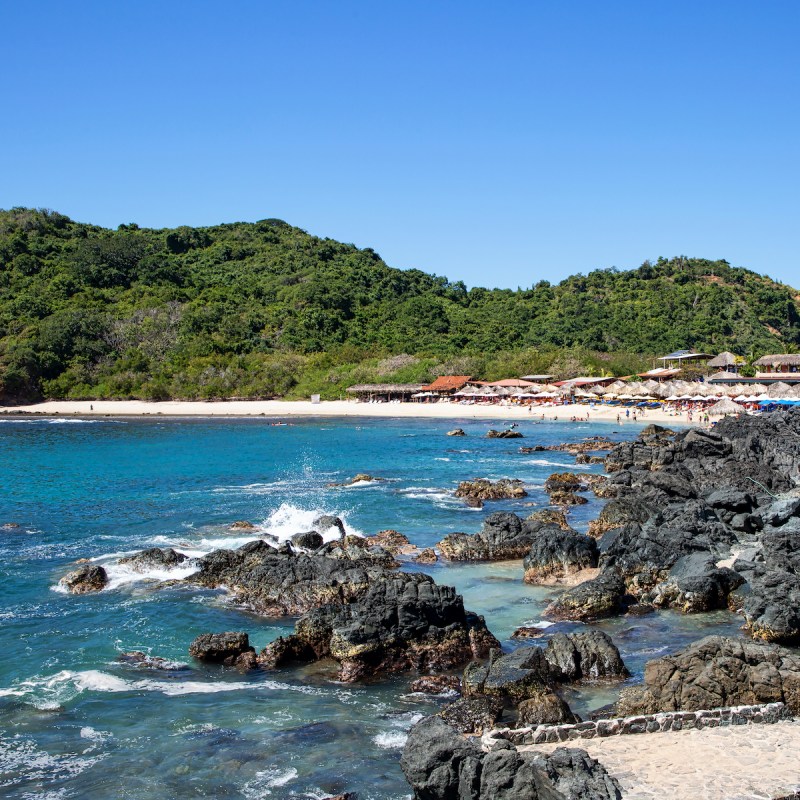
Once a fishing town, Zihuatanejo’s slow growth lead to a simple layout incorporating the eventual need for tourism. Easy to navigate, the Bay of Zihuatanejo is a short distance from all major points of interest. Those who stay near those areas are greeted by a variety of boutique hotels with the occasional national big brand and, of course, the beach — which is the big draw for visitors.
Videos by TravelAwaits
Ixtapa is also on the bay, only a few minutes via taxi, car, or bus. The town has a different feel from Zihuatanejo as the high-rise hotels stand side by side and popular hits play on loudspeakers. Small booths are only a few feet away from each other, all offering excursions and options to enhance your stay. The boardwalk goes in two main directions: out of town or into town.
Both areas complement and contrast each other. Go to Zihuatanejo for its more authentic, stripped-down, and earnest experiences, or go to Ixtapa for its glitz, glamour, luxury, and excitement.
To pit them against each other is unfair. They sit side by side making transiting between them so quick and interchangeable that to stay on either side depends on your personal preference.
So, my goal is not to show you which side is the best. Instead, it is to highlight what each part of the whole has to offer.
As mentioned, Zihuatanejo began as a fishing town. Its name comes from the Nahuatl word “Cihuatlan,” which means “land of women.” Various Indigenous tribes have lived on its shores — from the Cuitlatecs to the Tarascan — all claiming the region at one point.
After the Spanish arrival, the area accepted an influx of peoples from the Empire, as well as adventurous Filipinos, seamen, and various other travelers who brought an Asian influence to the region. The biggest example of this influence is the Shinto Gate in the center of town.
In the 20th century, the area served as a port of entry for goods throughout the state of Guerrero. As tourism became a focal point throughout the country, the area slowly converted into a budget tourist destination.
Unlike well-known destinations such as Cancun, Cabo, and Puerto Vallarta, Ixtapa is a lesser-known destination created in the late 1970s to meet the demand of tourists.
Its name also comes from various Nahuatl words for “white” and “salt.” The area had previously been a coconut plantation and mangrove estuary. Its fame came from the Mexican celebrities who lived in the area and from being the setting of a telenovela named Marimar during the mid-1990s.
Exploring both regions requires either a guide to take you directly to these destinations, a taxi, or if you are adventurous, riding the inter-town bus or walking. The buses have multiple stops in Ixtapa, while in Zihuanajeo the main start/stop is the Artisan Market on Calle 5 de Mayo. I would suggest using all of these options to quickly get to these various locations.

1. Bay Of Zihuatanejo
Zihuatanejo/Ixtapa
The differences between both areas are based on how they were constructed and then reconstructed. Each has a walking promenade (Malecon) that parallels the bay within the town limits. As you walk along the promenade, you’ll see small homes and businesses as well as romantic-themed seating areas above the water and rocks below. Small bridges provide quick access back to town.
Ixtapa has beaches adjacent to numerous hotels and a few restaurants. A dolphin-themed waterpark and marina provide easy access to a nautical golf course. It’s a perfect choice if you want some activity within sight of the beach.
Both have many beaches extending to areas remote from other visitors. Ixtapa has Playa Las Escolleras by the marina, Playa Thalia, and Playa Tulipanes. Zihua has Playa Las Gatas and my personal favorite, La Ropa Beach, named for the ships that went aground and the sailors who abandoned them, leaving much of their clothing to wash up on shore.

2. Partenon Del Negro Durazo
Zihuantanejo
In a difficult-to-reach location, this fading Greek-styled mansion was once the home of the corrupt Chief of Police of Mexico City. Arturo “El Negro” Durazo Moreno held the position from 1976 to 1982. During this time, his temperament, kickbacks, and a cocaine smuggling ring made him very wealthy, powerful, and feared.
One way he laundered his money was the construction of numerous homes, the most notable being this one. As it is a hike to reach this location, the ideal option is to take a taxi to the bottom of the hill and have them wait for you to return. Hike up a deteriorating walkway and pay the groundskeeper a few bucks to look the other way while you explore the mansion.
At first glance, you may think it is a hotel, but the pools, rooms, and faux statues tell a different story. You can see the effort put into its construction. The views of the bay below make the hike worthwhile.

3. Crocodile Farm
Ixtapa
Close to Playa Linda is a crocodile farm that is also a tourist attraction. This is an ideal brief stop, so you can see the special creatures that live in the estuary, such as iguanas and other lizards. Visting is free.

4. Isla Ixtapa
Ixtapa
There are two ways to visit the island of Ixtapa. The first is to book a tour that includes transportation to and from the island and a meal and beverages. The second is to take a taxi behind Club de Playa Tulipanes and then flag down one of the independent boat owners and negotiate the cost to reach the island.
Regardless of your choice, the visit is a fun mini-excursion from the mainland. The small island has a smooth side where most travelers stay and a rocky side that is completely covered in small rocks, so not very walkable. On this side, though, you will find fewer crowds, better views, and most of the restaurants.
These restaurants form a buffer between the two halves of the island. Staff stand by looking for signs that you are interested in something to eat or drink. They’ll try to wave you into their restaurant.
The beach is small, so it becomes crowded by late morning. There are a few hiking trails leading away from the main areas, but most visitors stay near the water and relax.
If you have decided to travel on your own reconnaissance, you will have to negotiate with one of the boat owners to take you back. Tour groups will only give you about 2 to 3 hours to enjoy yourself before heading back.

5. Xihuacan (La Chole) Museum
Petatlan
About 45 minutes outside of Ixtapa/Zihua is the Xihuacan Museum. Newly formed, the museum holds over 800 pre-Hispanic pieces displaying a wide range of items that give a rounded view of Indigenous life.
The best way to visit the museum is via a tour. Once there, you will learn about the Indigenous Nahua people who were the first to the region, as well as the Aztec, Toltec, Xochimilco, and other groups.
An added bonus of visiting the region is a visit to the pyramid. There, you can see the area through the eyes of its one-time inhabitants and get great views of the surrounding area.

6. Foodie Culture And Craft Beer
Zihuatanejo
Although Ixtapa has many nice restaurants, I felt those were geared towards tourists who wanted meals with a bit of Mexican flair but closer to what they ate at home. The more glamorous and upscale restaurants are within Ixtapa.
What I gravitated to was the fare on the Zihua side. These meals were favored by the locals — simple food, ample portions, and reasonable cost.
The best overall destination to try a large selection of local dishes while being entertained is at the Mercadito Zanka, which is open only Wednesday through Sunday evenings. This is where you can try a little of everything in one place.
Pasteleria La Boquita has delicious breads and pastries whose smells will attract you to their location.
Mercado Municipal (City Market) has a number of food stalls in the surrounding area. My personal favorite is Taqueria Las Esquinita, which became my late breakfast and early lunch location. My local fast-food go-to is, and has always been, Taqueria El Buen Pastor. I actually salivated when I walked by. My late-night go-to was Mr. Lalo Hamburguesas Al Carbon. For drinks, I visited Capricho del Rey for the selection of craft drinks and the friendly staff. When I have a craving for some pizza, then it’s Pizza Locas.

Final Thoughts
I prefer to visit the beach shortly after the sun rises. At that time, the crowds have not arrived. You can have some quiet time to enjoy the environment. The sand is cool. The sun fills the bay, and this is one of the best features of Zihuatanejo/Ixtapa.
These two distinct towns were reconstructed to accommodate the surge of tourism after the 1970s. Yet away from the tourism destinations, these areas still retain their local charm and off-the-grid feeling.
Your leisure time should always be spent enjoying yourself and relaxing. Paso del Pescador (Zihua) and Paso Ixtapa (Ixtapa) give you good opportunities. The rest depends on you.

